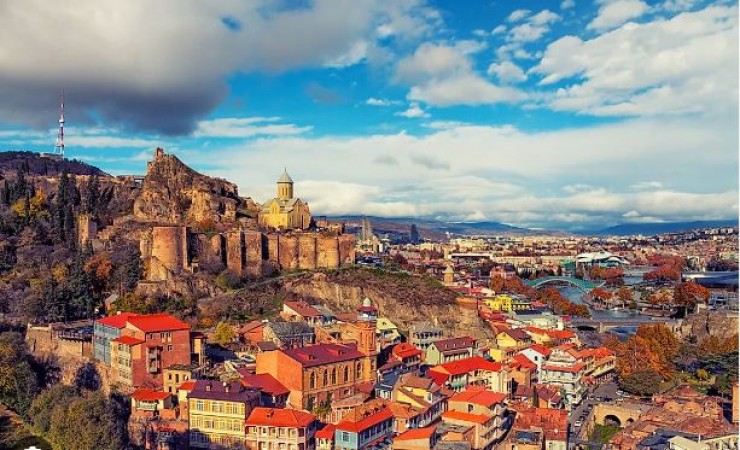
Georgia, officially known as the Republic of Georgia, is a small country located at the crossroads of Eastern Europe and Western Asia. It is bordered by Russia to the north, Azerbaijan to the southeast, Armenia to the south, and Turkey to the southwest. The country has a rich history and a diverse cultural heritage that has evolved over thousands of years.
Georgia's diverse landscape ranges from high mountains to lowland areas and stretches across approximately 69,700 square kilometers. The Greater Caucasus mountain range runs along the northern border of the country, while the Lesser Caucasus extends in the south. Mount Shkhara, the highest peak in Georgia, stands at an elevation of 5,201 meters.
Also Read: Ultimate Packing Tips for an Unforgettable Trip to XYZ Destination
The country's climate varies from subtropical to alpine, influenced by its geographic location. The western regions experience a mild maritime climate, while the eastern areas have a more continental climate with hot summers and cold winters.
Georgia's history dates back to ancient times. It was home to various tribes and kingdoms, including the Colchians and Iberians. The region was conquered by the Persians, Greeks, Romans, and Byzantines before the emergence of the Kingdom of Georgia in the 11th century under King Bagrat III. The Georgian Kingdom experienced periods of prosperity and decline, often facing invasions by neighboring empires.
In the 18th century, Georgia became a target of expansion for the Russian Empire. By the early 19th century, Georgia was annexed by Russia, leading to the abolishment of its monarchy and the incorporation of the territory into the Russian Empire. Throughout the 19th century, Georgians actively participated in efforts to gain independence from Russian rule.
Also Read: The Enchanting Charm of Provence: A Journey Through Time and Beauty
Following the Bolshevik Revolution in 1917, Georgia briefly achieved independence in 1918, but it was short-lived as it fell under Soviet rule in 1921. During the Soviet era, Georgia was one of the republics within the USSR and experienced both industrialization and Russification policies. Despite this, Georgian culture and identity remained resilient.
After the dissolution of the Soviet Union in 1991, Georgia declared its independence and became a democratic republic. However, the early years of independence were marked by political instability and economic challenges.
During the 1990s and early 2000s, Georgia faced internal conflicts, including the Abkhazia and South Ossetia conflicts, which resulted in de facto independent states within Georgia's borders. These conflicts have had lasting impacts on the country's territorial integrity and have complicated Georgia's path to stability and development.
In 2003, Georgia experienced a significant political shift through the "Rose Revolution," led by Mikheil Saakashvili. This peaceful uprising ousted the government and ushered in a new era of democratic reforms, anticorruption efforts, and pro-Western policies.
Also Read: Nice, France: A Mediterranean Gem
Georgia has since focused on European and Euro-Atlantic integration, aiming for membership in NATO and the European Union. The country has made progress in implementing democratic reforms, enhancing its economy, and improving its business climate. However, challenges remain, including issues related to governance, corruption, and territorial conflicts.
Georgia boasts a unique and ancient cultural heritage. The Georgian language, one of the oldest languages still in use, is written in its own distinctive script. Georgian literature, music, and dance have flourished throughout history, reflecting the nation's deep-rooted traditions.
The Georgian Orthodox Church plays a significant role in the country's culture and identity. It has a history dating back to the 4th century and continues to be an essential institution in the lives of many Georgians.
Also Read: Marseille, France: Remarkable Cultural Diversity
Georgian cuisine is renowned for its distinctive flavors and diverse dishes. Traditional Georgian meals often include Khachapuri, a cheese-filled bread, and Khinkali, dumplings filled with meat or cheese. Wine-making has a long history in Georgia, and the country is considered one of the earliest cradles of viticulture and winemaking.
Georgia's breathtaking landscapes, historic sites, and warm hospitality have made it an increasingly popular tourist destination in recent years. Tourists are drawn to the ancient city of Tbilisi, the cave city of Uplistsikhe, the picturesque Svetitskhoveli Cathedral, the wine region of Kakheti, and the stunning mountain landscapes of Svaneti and Kazbegi.
Also Read: Lyon, France: A Gastronomic Journey
Georgia's rich history, diverse culture, and stunning landscapes make it a fascinating and enchanting country. Despite facing challenges, the Georgian people have shown resilience and determination to build a democratic nation with a distinct identity on the global stage. As Georgia continues to pursue its European aspirations and address internal issues, it remains a nation with great potential and a bright future ahead.
Also Read: 5 Popular Temples In Andhra Pradesh
The French Riviera: A Mediterranean Jewel of Elegance and Charm